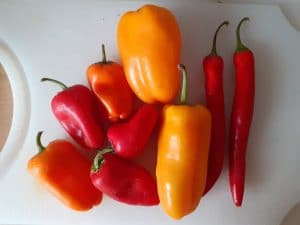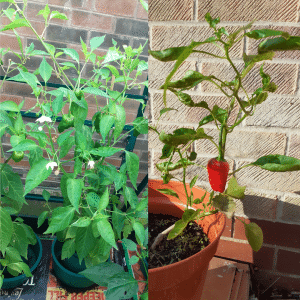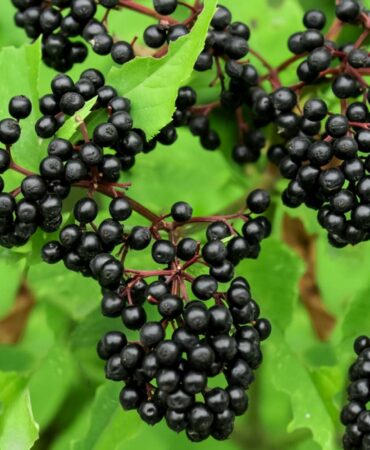Currently Empty: £0.00

Herb Histories: Chillies – A World of Words
We hurriedly rush in from the cold, slamming the front door shut, sighing in relief as the feeling returns to our fingers and to our toes; if you’ve been feeling the winter chill, then get ready to escape to a world of warmth and spice with a Herb History with Helen, all about Chillies.
Written by Helen Miller
The Chilli has many different names, and many potential benefits. The Aztecs and Mayans were very familiar with this, sometimes ferocious, fruit. It was valued both as a cultivated and a wild plant. It spread around the world almost as quickly as the capsaicin makes itself felt on your tongue and we’re still discovering new species. So, is there anything subtle about a Chilli?
What’s In A Name?
The scientific name for the genus of the fruit we recognise as the Chile is Capsicum. The name Capsicum comes from the Greek ‘to bite’7 and was adopted by Carl Linnaeus in 1753.10
The word Chilli originally comes from the native Nahuatl (Aztec) dialect word for the Capsicum plant ‘chil’. ‘Chile’ is the Hispanic variation of this word whereas Chilli with the ‘i’ is the English version. ‘Chile’ is the name for the Capsicumpeppers (pungent or not) whereas ‘chili’ is the Texan state dish featuring pungent spices (including Capsicum with a few others) and meat. Another word for Chilli is ‘aji’ which is derived from ‘axi’ the word for Chilli in the, now extinct, Arawak dialect of the Caribbean.3
All of these words are generally used interchangeably, along with ‘pepper’, ‘pimiento’, ‘paprika’ (from the German and northern European languages)10 and ‘rocoto’. This makes Capsicum terminology rather confusing.

Speciation of Chillies
Usually where a genus originates is determined by looking for the area of the globe where there is the greatest diversity of species in that genus. If the pungent species are looked at as separate from the non-pungent species, then the centre of diversity for the pungent species is from southern Brazil to Bolivia. However, it is believed that the pungent and non-pungent Capsicum species should be grouped together. This means the centre of diversity should be recognised as ranging from Central America to southern Mexico.6
There are currently 42 species of Capsicum recognised by science. Two of these species have only just been discovered and described this year.1, 2 All of the species of wild Capsicum have been valued and used by the people living in the region where they traditionally grow3 but only five of these species are found growing around the world in any great numbers.
The main species identified as a Chilli by most people is C. annuum. This species includes bell peppers, as well as the pungent cayennes and jalapeños, and it was the first Capsicum discovered by Colombus in 1492. C. frutescens includes the Thai, bird and tabasco peppers, C. chinense are the hottest naga, habañero and Scotch bonnet peppers, C. pubescens are the rocoto peppers and C. baccatum are the aji peppers.4

The Spread of a Ferocious Flame
After Colombus discovered Chillies in Central America during the fifteenth century they spread through Europe quickly, and from there into Africa and Asia. They were popular because the pungency was similar to that of Black Pepper, Piper nigrum, but because it was a red fruit, Columbus called it Red Pepper. Capsicum and Piper are actually distinct, and not very closely related, plant genera. Strangely, Chillies entered into local cuisines with very little delay after their introduction. They seem to have been used as a substitute for Black Pepper by people at the poorer end of society. Before the introduction of Chilli, a spice like Black pepper had only been available to people who could afford luxury spices.4
Traditional Uses of Chillies
Chillies have been used for thousands of years by the Aztecs and Mayans as medicinal herbs. Studies of the pharmacopeia of the Mayans in Mesoamerica have found that they had over 32 medicinal uses for Chillies, including stomach aches, skin rashes, rheumatism and arthritis.9 The use of Chillies as a digestive aid is a traditional way of using them in the West Indies. In Mexico, they were used as medicine and to fumigate houses. Mrs Grieves notes that the Chilli was introduced to Britain from India in 1548.7
By 1653, Culpepper was using Capsicum frutescens, specifically Cayenne and Bird Peppers, although he was saying it was a native of India (as Mrs Grieves did later on in her herbal. Chillies were actually introduced from the West Indies via India). His notes on how to cultivate it sound like it was commonly grown in Europe: “…will bear our climate, and ripen its fruit if brought forward in a hot bed in spring,…”5 Culpepper’s warning about the irritating effects of the fumes and not to rub the eyes with your hands after touching the fruits also seem to show a great familiarity with the effects of the Chilli.
Medicinally, Culpepper used the fruits as a carminative (to aid digestion), an expectorant (to expel fluids/mucous) and a diuretic (to stimulate the kidneys). He also used the fruits as a powder in mixes with other herbs, for example with Gentian powder and Bay oil in an electuary to aid “inveterate coughs”.5 All of which makes it sound as if Chillies were well known and widely used in the seventeenth century.
At the start of the 20th century Chillies were used as local stimulants and carminatives, but not for gastric ulcers. They were mainly used in the form of pills and powders but could also be used externally as a rubefacient (to dilate capillaries in the skin and increase blood flow to that area of skin).7

Modern Uses of Chillies
The chemical constituents in Chillies that give them their pungent characteristic are the capsaicinoids. The main capsaicinoid is capsaicin. This constituent has been found to have anti-oxidant, anti-inflammatory, hypolipidemic (reduces cholesterol and triglycerides), thermogenic and weight-reducing effects that could be beneficial in a number of conditions. Recently, it has been found that Metabolic Syndrome could be one of these. People with Metabolic Syndrome (or syndrome X) develop abdominal obesity, insulin resistance, hypertension and dislipidemia and the syndrome has been identified as the main risk factor for developing cardiovascular disease and Type II diabetes.8
Chillies are not just beneficial if a person is ill. They have many benefits when they are consumed in dietary amounts. These include actions in the gastrointestinal tract such as digestive stimulation, increasing fat digestion, increasing the gastrointestinal motility (movement of food through the gut) as well as protecting the gastric mucosa (the lining of the gastrointestinal tract). They can also improve a person’s iron status and benefit the circulatory system.9
Chillies consumed as Chilli sauces have also been studied and found to produce an anti-microbial action to some, but not all, micro-organisms. Combining a couple of the constituents of Chilli together, or combining capsaicin with salt, may provide a preservative that can be added to food so it can be easily preserved without the need to add chemicals.9
People are really only just starting to uncover the many benefits that the Aztecs and Mayans knew Chillies can provide. Maybe all these unexpected benefits show a subtler side to this vibrant fruit?
Herb Histories has been a new blog series for 2020, if you have enjoyed it and would like to subscribe to the blog to be the first to read our latest articles, email ‘blogs please’ to blog@herbsociety.org.uk.
References
- Barboza, G.E, Carrizo García, C., Scaldaferro, M. and Bohs, L. (2020) An amazing new Capsicum (Solanaceae) species from the Andean-Amazonian Piedmont, PhytoKeys 167: 13–29, doi: 10.3897/phytokeys.167.57751.
- Barboza, G.E, de Bem Bianchetti, L. and Stehmann, J. R. (2020) Capsicum carassense (Solanaceae), a new species from the Brazilian Atlantic Forest, PhytoKeys 140: 125–138, doi: 10.3897/phytokeys.140.47071.
- Bosland, P.W. (1996) Capsicums: Innovative uses of an ancient crop. p. 479-487. In: J. Janick (ed.), Progress in new crops. ASHS Press, Arlington, VA.
- Bruton-Seal, J. and Seal, M. (2020) Kitchen Medicine: Household Remedies for Common Ailments, Merlin Unwin Books, Ludlow, Shropshire, UK.
- Culpepper, N. (1653) Culpepper’s Complete Herbal: consisting of a comprehensive description of nearly all herbs with their medicinal properties and directions for compounding the medicines extracted from them, W. Foulsham & Co., Ltd., London.
- Eshbaugh, W.H. (1993) History and exploitation of a serendipitous new crop discovery. p. 132-139. In: J. Janick and J.E. Simon (eds.), New crops. Wiley, New York.
- Grieves, M. (1998) A Modern Herbal, Tiger Books International, London.
- Jang, H.-H., Lee, J., Lee, S.-H. and Lee, Y.-M. (2020) Effects of Capsicum annuum supplementation on the components of metabolic syndrome: a systematic review and meta-analysis, nature.com/scientificreports.
- Salehia, B., Hernández-Álvarezc, A. J., del Mar Contrerasd, M., Martorelle, M., Ramírez-Alarcóne, K., Melgar-Lalannef, G., Matthewsg, K. R., Sharifi-Radh, M., Setzeri, W. N., Nadeemj, M., Yousafk, Z. and Sharifi-Radl,J. (2018) Potential Phytopharmacy and Food Applications of Capsicum: A Comprehensive Review, Natural Product Communications, 13(11):1543-1556.
- Tripodi, P. and Kumar, S. (2019) The Capsicum Crop: An Introduction, In N. Ramchiary and C. Kole (eds.), The Capsicum Genome, Compendium of Plant Genomes, https://doi.org/10.1007/978-3-319-97217-6_1.




